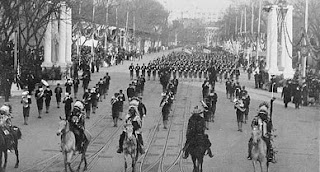* By Jesse Rhodes
* Smithsonian.com, January 14, 2009
 Elected to serve a full term as president of the United States, Theodore Roosevelt—who initially took the oath of office after the 1901 assassination of President William McKinley—was about to enjoy his first inaugural parade. On March 4, 1905, he sat in the president’s box with his wife, daughter and other distinguished guests to watch the procession of military bands, West Point cadets and Army regiments—including the famed 7th Cavalry, Gen. George A. Custer’s former unit that fought at the Battle of Little Bighorn—march down Pennsylvania Avenue. Roosevelt applauded and waved his hat in appreciation and then suddenly, he and those is his company rose to their feet as six men on horseback came into view.
Elected to serve a full term as president of the United States, Theodore Roosevelt—who initially took the oath of office after the 1901 assassination of President William McKinley—was about to enjoy his first inaugural parade. On March 4, 1905, he sat in the president’s box with his wife, daughter and other distinguished guests to watch the procession of military bands, West Point cadets and Army regiments—including the famed 7th Cavalry, Gen. George A. Custer’s former unit that fought at the Battle of Little Bighorn—march down Pennsylvania Avenue. Roosevelt applauded and waved his hat in appreciation and then suddenly, he and those is his company rose to their feet as six men on horseback came into view.
The men were all Indian chiefs—Quanah Parker (Comanche), Buckskin Charlie (Ute), American Horse (Sioux), Little Plume (Blackfeet), Hollow Horn Bear (Sioux) and Geronimo (Apache)—and each was adorned with face paint and elaborate feather headdresses that attested to their accomplishments. However, the causes they fought for over the course of their lifetimes were at odds with those of the American government.
Indeed, the newspapers of the day were quick to remind readers of the Indian wars, emphasizing the blood spilled by frontier settlers at the hands of Native Americans, going so far as to label them savages. Woodworth Clum, a member of the inaugural committee, questioned the president’s decision to have the chiefs participate, especially Geronimo, who was first captured by Clum’s father, an Apache agent.
“Why did you select Geronimo to march in your parade, Mr. President? He is the greatest single-handed murderer in American history?” asked Clum.
“I wanted to give the people a good show,” was Roosevelt’s simple reply. But their inclusion in the parade was not without another purpose.
Flanking the chiefs were 350 cadets from the Carlisle Indian Industrial School in Pennsylvania. Capt. Richard Henry Pratt established the school in 1879 to “Americanize” Native American children, forcing them to abandon all facets of tribal culture. On arrival, students were re-clothed, renamed and began the process of being recast in the image of the dominant white culture, which involved everything from adopting the English language to being baptized under non-Native religions. Their presence in the 1905 inaugural parade was intended to showcase a new reality of Native American living. (Even American Horse had children at Carlisle, hoping that a Western education would allow them to better adapt to a rapidly changing world.)
“The driving idea about Native Americans,” says Jose Barreiro, a curator at the National Museum of the American Indian, "was represented by Colonel Pratt who was the head of the Carlisle Indian School and his famous phrase, 'Kill the Indian, save the man,' meaning take the culture out of the Indian.”
At best, the cadets received passing mention in the newspapers and nobody bothered to photograph them. All eyes were on the six chiefs. These men needed to be visible; for them, failure to remain in the public consciousness meant their people—and the problems they were facing—would be forgotten. “The Indian was ‘out of sight, out of mind’ at that point,” says Barreiro. “The notion in the 1900s was that the Indian was going to disappear—the vanishing American.”
